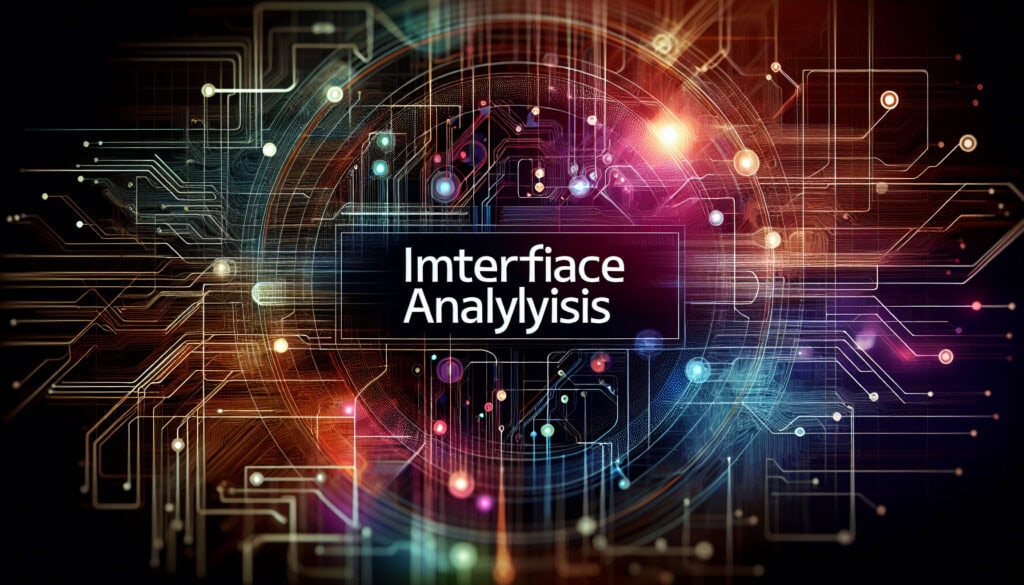Identificare e analizzare le interfacce tra diversi sistemi o componenti.
- Metodologie: Clienti e marketing, Ideazione, Progettazione del prodotto
Analisi dell'interfaccia

Analisi dell'interfaccia
- Interfaccia di programmazione dell'applicazione (API), Progettazione per la produzione (DfM), Ottimizzazione del design, Interazione uomo-computer, Sistema di gestione della qualità (SGQ), Linguaggio di modellazione dei sistemi (SysML), Esperienza utente (UX), Interfaccia utente (UI)
Obiettivo:
Come si usa:
- A systematic process for identifying and analyzing the interfaces between different systems, subsystems, or components. It is used to ensure that the interfaces are complete, consistent, and well-defined.
Professionisti
- Helps to ensure that systems will work together correctly; Can identify potential integration problems early in the development process.
Contro
- Can be time-consuming and complex to perform; Requires a deep understanding of the systems being analyzed.
Categorie:
- Ingegneria, Gestione del progetto
Ideale per:
- Ensuring that different systems or components will be able to communicate with each other effectively.
Interface Analysis plays a significant role in the design and development of interconnected systems within various industries such as aerospace, automotive, software development, telecommunications, and robotics. This methodology is typically applied during the system engineering phase of a project, particularly when multiple teams or stakeholders are involved in creating components that will interact with one another. It encourages collaboration among engineers, designers, and project managers to create a comprehensive understanding of how interfaces will function and be utilized. Initiating this process often involves system architects or lead engineers who facilitate workshops or discussions to map out the interaction points, ensuring that design specifications are aligned with integration requirements. Throughout the ciclo di vita del prodotto, Interface Analysis can be revisited, particularly during the verification and validation stages, when prototypes are tested to confirm that all systems communicate as intended. This approach not only identifies compatibility issues early on but also lays the groundwork for robust documentation that can streamline future maintenance and upgrades, making it easier for teams to implement changes without disrupting existing functionality. Applications include developing communication protocols for IoT devices, ensuring safety standards in automotive systems, or coordinating software modules in a cloud infrastructure, all of which require meticulous attention to how individual components will process and share information.
Fasi chiave di questa metodologia
- Identify systems, subsystems, or components that require interface analysis.
- Define the functional requirements for each interface.
- Document current interface specifications and standards.
- Analyze the interactions between systems or components, focusing on data flow and control.
- Identify potential conflicts or incompatibilities in interface design.
- Develop interface design solutions that address identified issues.
- Iterate the design based on feedback and testing outcomes.
- Verify interface compliance with defined requirements.
Suggerimenti per i professionisti
- Utilize model-based systems engineering (MBSE) to create a visual representation of interfaces, enhancing clarity and communication across all teams involved.
- Conduct interface control document (ICD) reviews regularly throughout the development lifecycle to verify adherence to interface specifications and standards.
- Implement rapid prototyping of interfaces to test interoperability early, allowing for quick identification of discrepancies and iterative refinement before full-scale production.
Leggere e confrontare diverse metodologie, raccomandiamo il
> Ampio archivio di metodologie <
insieme ad altre 400 metodologie.
I vostri commenti su questa metodologia o ulteriori informazioni sono benvenuti su sezione commenti qui sotto ↓ , così come tutte le idee o i link relativi all'ingegneria.
Contesto storico
1980
1980
1986
1987
1990
1990
1990
1980
1980
1986
1986
1987-03
1990
1990
1992
(se la data non è nota o non è rilevante, ad esempio "meccanica dei fluidi", viene fornita una stima approssimativa della sua notevole comparsa)















Post correlati
Questionari sul disagio muscoloscheletrico
Test multivariati (MVT)
Analisi di regressione multipla
Sistemi di cattura del movimento
Metodo MoSCoW
Test mediano dell'umore